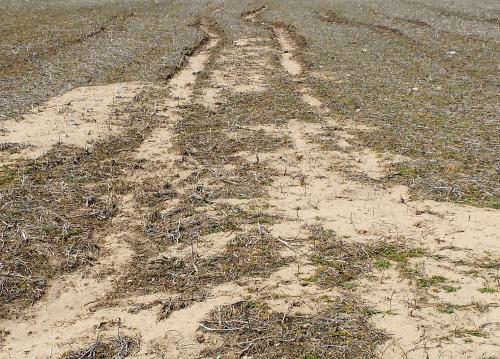Repairing harvest ruts this spring
Recommendations for repairing harvest ruts prior to planting without causing further soil compaction.

Unfortunately, harvest ruts are a common problem this spring. Two weather-related factors contributed to this situation. First, the dry weather that occurred from mid-May to early July 2023 delayed corn and soybean emergence by four to six weeks in fields that were planted after May 15, 2023. The early season drought also delayed soybean development by two weeks in fields that emerged prior to May 15. Frequent fall rains kept soils continuously wet, which also led to significant harvest delays. As a result, harvest equipment left ruts in these fields. In some cases, the ruts are more than 6 inches deep and in others, they are only 3 inches deep.
Many of the harvest ruts are confined to localized areas within fields. However, there seems to be more fields where deep ruts created by every pass of the combine can be seen (Photo 1). If the ruts run up and down a slope, the ruts need to be filled as soon as the soil is suitable to prevent soil erosion from turning them into deep gullies (Photo 2). All ruts deeper than your projected planting depth must be leveled prior to planting for planters and drills to perform properly.

When repairing ruts this spring, the objectives are to fill and level the ruts just enough to facilitate planting operations without causing further soil compaction. In the spring, the soil dries by drainage to field capacity and then by evaporation from the surface down. For trafficking the soil without causing soil compaction, the soil needs to be below field capacity. Field capacity usually occurs two to three days after a saturating rain event and fields have been allowed to drain. For tillage operations, the soil should be 90-95% of field capacity to the depth of tillage. Evaporation is slow with cold soil and air temperatures, so waiting for deeper drying delays fieldwork.
The recommendation is to first till only as deep as needed to fill the ruts and fit the seedbed for planting. Plan to address deeper compaction at the bottom of deep ruts later in the fall, after harvest, when soil moisture is right for tillage at deeper depths. Run the tillage tool an inch or two below the bottom of the ruts in the fall. The soil is too wet at that depth in the spring and deep tillage is likely to cause more compaction. If the tillage tools smear the soil, it is likely too wet for tillage.
Michigan State University Extension recommends secondary tillage implements such as disks, field cultivators, soil finishers and vertical tillage for repairing ruts 2-4 inches deep. For ruts deeper than 4 inches, a chisel plow may be necessary. Always operate the implements as shallow as possible to fill and level the ruts. Multiple passes may be required to achieve the desired degree of leveling.
Perform tillage operations when the soil at or just above the operating depth is dry enough to prevent soil smearing and compaction. Mark Hanna, an agricultural engineer with Iowa State University who is now retired, recommends the following methods for assessing soil moisture conditions:
- Collect a handful of soil from an area between ruts and 2 inches above the operating depth of the tillage tool and form it into a ball. Then throw the ball of soil as if throwing a runner out at first base. If the ball stays mostly intact until it hits the ground, the soil is too wet to till.
- Take a similar soil sample in your hand and squeeze the soil in your fist and use your thumb and forefinger to form a ribbon of soil. If the ribbon extends beyond 2-3 inches before breaking off, the soil is too wet to till. This method only works for soils with a high clay content.
Paul Jasa, agricultural engineer at the University of Nebraska, recommends the following methods to assess soil moisture levels prior to performing tillage operations:
- Collect a handful of soil from your desired tillage depth and squeeze the soil in your fist. If moisture and soil cling to your palm, the soil is too wet.
- Take a similar soil sample and form it into a ball and drop it to the ground from about waist high. If the ball remains mostly intact or breaks into only a few pieces, the soil is too wet.
Remember, your objectives with spring rut repairs are to fill and level the ruts without causing further soil compaction. Attempting to loosen the soil below the ruts increases the potential for further soil smearing and compaction to occur.



 Print
Print Email
Email